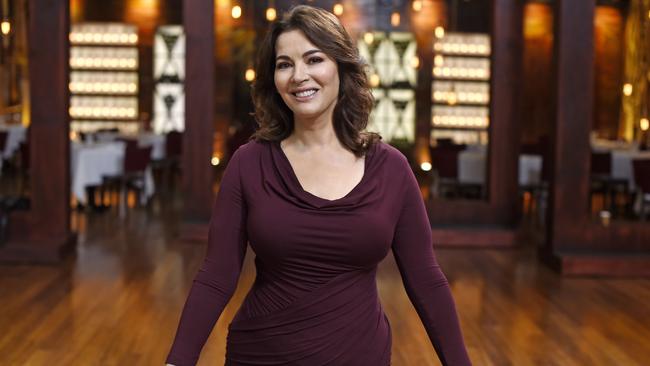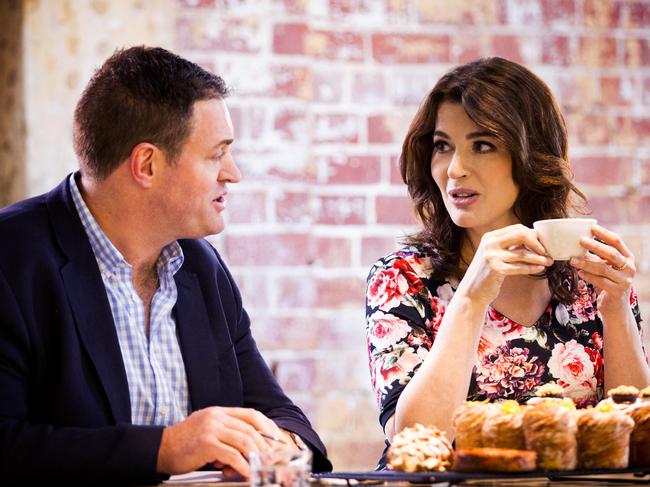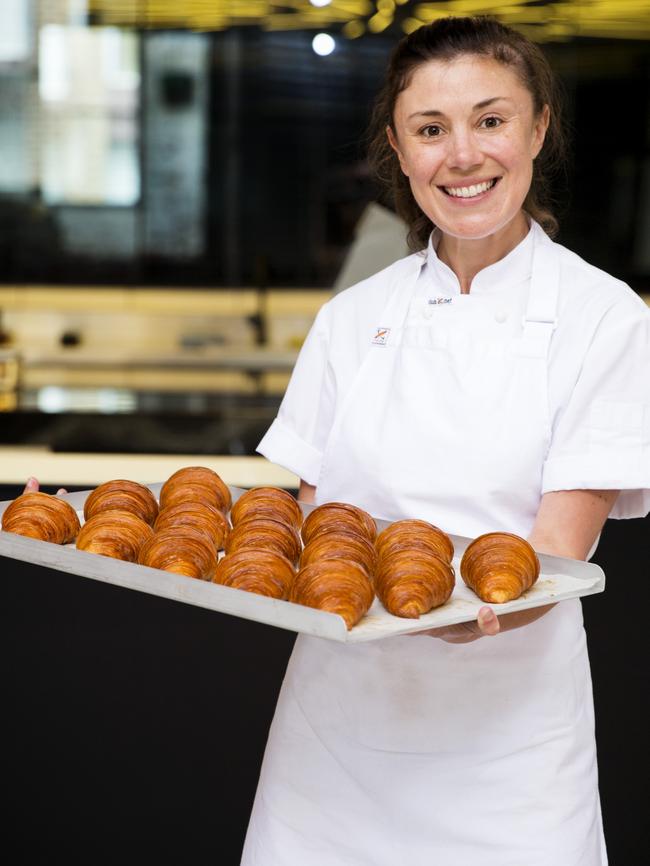Nigella Lawson’s MasterChef stint forges a new bond in bold tastes
There are good reasons why Nigella’s unpolished, bold, home-style cooking has been such a hit in Australia.

She has graced the cover of Vogue, practically invented food porn and is probably the most recognisable female cook in the world — which makes Nigella Lawson’s lament about the demands of fame all the more surprising.
“If I never had my photograph taken again I wouldn’t be unhappy,” she says. “But I started as a journalist, I write about food and I do like communication with people. I like to meet readers and I like to talk about food.”
This may seem at odds with the woman who has just been striking pose after pose for the camera as part of the publicity for MasterChef, but it makes perfect sense: Lawson is as much about the written word as the image.
(True, she travels with a stylist, but that’s a reality for women in the public eye, especially one who looks a decade younger than her 56 years.)
The dialogue that can seem over-egged on screen has a different resonance on the printed page. After all, Lawson — the Oxford-educated daughter of a senior minister in Margaret Thatcher’s government — started her working life writing literary reviews and opinion pieces for newspapers.
“What brought me into the food world was language; it interested me to try to write about it because I was interested to see whether language, which is abstract, could be used to evoke a world that so clearly belongs to the realms of the senses,” she says. “Cooking and writing are similar in the way reading and eating are. I like the taste of words.”
Lawson is in town to promote MasterChef, in which she appears next week, and conducting a day of back-to-back interviews from the confines of a city hotel.
However, she is only too happy to take up the offer of lunch at Melbourne’s bakery du jour, Lune Croissanterie, for coffee and elegant patisserie. It’s a break from her arduous schedule and a chance to see first-hand the excellence of local chefs — and she’s impressed.
“I couldn’t make pastries like this,” she enthuses. “I’m very much a home cook, which is different. The skill that goes into these is immense.”
Lawson’s voice is clear in her written work. Take this passage from her latest book, Simply Nigella, about using cast-iron pans: “I find both the ancient ore they are forged from, and their steady heft, reassuring.”

But while the language may be poetic, the message is prosaic. There’s no cheffy self-aggrandisement; quite simply, she wants to get people cooking. As one of the small-screen heavy hitters who can cause supermarket shortages by using a certain ingredient — a la “the Jamie effect” — how does she define the Nigella effect?
“I hope it’s made people realise you don’t need a qualification or exceptional skills or dexterity to cook,” she says. “I have no (cooking) qualifications and no training, I’m incredibly clumsy, I chop badly, I burn myself quite a bit, I make mistakes, but I get things how I want them, and I think things don’t have to be show-offy to be delicious.”
Her unaffected gusto for cooking finds a natural affinity with Australian tastes. “I don’t mind going bold on flavour,” Lawson says.
“I mix things up a bit, which is a bit like the Australian attitude. I like the relaxed attitude towards food — there’s no stress, you can sense the enjoyment.”
Whether the same can be said of the MasterChef contestants who take on her “pressure test” is another thing, though Lawson is full of admiration for them.
“I think the standard is very high. I think they’re very good. So many go on to work in food and because of that it does encourage people who are good and it keeps it all going — it’s like a fellowship. It seems once that series has gone, those people aren’t forgotten.”
Profiles of Lawson often focus on the physical as much as the food, which may seem superficial but recognises her capacity for empowerment. A healthy appetite — in both senses — is no bad thing.
But portraying Lawson as a poster girl for guilt-free eating misses the point: her maxim isn’t “eat what you like” so much as “like what you eat”. You can have your cake and eat it, just not the whole cake. “I don’t do dessert ever, normally,’’ she says. “I would never think of doing it day to day. The whole point is that it’s special and a treat.
“I think a lot of people have that obsession with sweet things because they’re always trying not to eat them. Put a packet of salt and vinegar crisps in front of me and I find that far more of a challenge.”
(She scoffs at the suggestion that she might be up at 5 o’clock every morning to pound the treadmill. “I don’t look like someone who is,” she says, genuinely self-deprecatingly.)
Lawson’s ethos led her into some choppy waters recently when she elaborated on more faddish diets.
She says: “I don’t like the term ‘clean eating’ — it comes from a place that somehow eating is a bit dirty and there’s a shame attached, but if you’re asking whether I think food that’s fresh and isn’t processed is a good thing, of course it is. I also am very aware that for many people it does become something that can tilt an unhealthy relationship with food in the wrong way.”
This is perhaps a nod to Lawson’s acknowledgment that her mother, Vanessa, had endured an eating disorder, though questions about family are strictly off limits — a legacy of her annus horribilis of 2013. That was the year her disintegrating private life became tabloid fodder: first ex-husband Charles Saatchi manhandled her on a restaurant terrace, then the trial of her former personal assistants aired plenty of dirty washing.
Is cooking her “safe place” to which she retreats? “It has been in the past,” she says. “I can’t separate cooking off into something outside of myself.” She comes across as remarkably grounded (“I don’t go to premieres and that sort of thing”) and says: “I have proper friends. I don’t have the kind of life where I meet people who confuse me with some image that’s projected on to me, because they know me and they know me well.”
We also may feel we know her well, with her having been on our screens for 18 years. When Lawson was a journalist, she never thought she’d become a food writer, so what will she be doing in another 18 years?
“Professionally, who knows? That’s what I find exciting. I sometimes think I might do something completely different. The world is divided into those who make plans and people who feel very claustrophobic with plans, and I’m someone who cannot bear thinking about what I should do in the future.
“When people say, ‘What are your goals?’, I’ve never had a goal in my life.”
Then she makes what could be a commentary on the slings and arrows she has endured without ever losing her poise.
“The way I feel that life is, you can’t plan for things. You never know what’s going to happen, you can’t take anything for granted, so I wouldn’t want to jinx myself by making plans for the future.”
MasterChef Nigella Week airs on the Ten Network from Sunday, May 22, at 7.30pm.

Almond croissants
If you’d like to try replicating one of the perfect pastries that so impressed Nigella Lawson, give these almond croissants a whirl, courtesy of Lune Croissanterie’s Kate Reid — although the recipe for the actual croissants remains a closely guarded secret. This makes a batch of 10, so amend quantities to suit, but — importantly — the croissants should be yesterday’s.
Ingredients: 125g caster sugar | 10 x one-day-old croissants | 45g flaked almonds | icing sugar, for dusting
Frangipane: 250g butter (room temperature) | 250g caster sugar | Three eggs | 250g almond meal
Preheat oven to 200C (180C fan-forced). Line a large baking tray with paper. To make the frangipane, beat the butter and sugar on low speed with an electric mixer until light and fluffy (about 2-3 minutes). Add the eggs one at a time, fully incorporating each before adding the next. Mix in the almond meal then transfer to a piping bag.
In a small saucepan, heat 250ml of water with the sugar over medium heat, stirring until sugar dissolves. Bring the syrup to the boil then remove from heat. Cut the croissants in half lengthwise and brush the cut sides of each with syrup. Pipe a generous amount of frangipane on the bottom half of each croissant and sandwich with the top halves. Top each croissant with a piped seam of frangipane and finish with the flaked almonds.
Place the croissants on the tray and bake for 18-20 minutes until the frangipane is set. Once cooled, dust with icing sugar.
